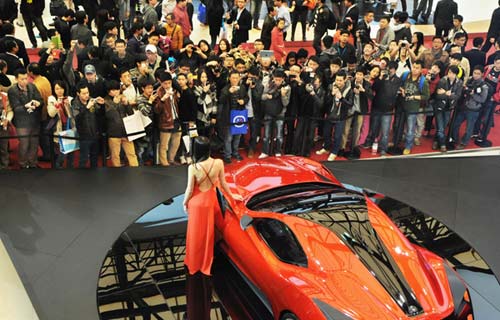Modern dance pushes frontier of nakedness
Updated: 2012-08-26 08:00
(The New York Times)
|
|||||||||||
|
|
In experimental modern dance, nakedness is now a widespread condition. A bigger surprise has been to find that sometimes it succeeds. And when it does, it changes our perception of muscles and flesh. Its effect is one of drama. Exposure of the unadorned body has even started to alter the world of ballet.
Recently, several instances of nakedness have extended the frontiers of liberation; the majority of the more advanced examples have featured men.
In 2010, I watched a work by Christopher Williams called "Gobbledygook" in which the dancer Adam H. Weinert - nude while other performers remained clad - stood with his back to the audience and bent over, enabling (or obliging) the audience to observe the crack between his buttocks and a rear view of his genitalia.
At the end of "Crotch (all the Joseph Beuys references in the world cannot heal the pain, confusion, regret, cruelty, betrayal, or trauma....)," a 2009-10 solo show by Keith Hennessy, he sat naked but with his groin covered in lard. He gathered us, the audience, around him onstage. Pushing a needle with blood-red thread through scars in his own flesh, he sewed the thread through the clothing of the three people seated nearest him. He then gave lingeringly searching gazes into our eyes.
Even for those of us who have now seen a great many naked bodies onstage, the bent-over rear view of Mr. Weinert in "Gobbledygook" was something new. It was not, however, a problem. That use of nakedness made Mr. Weinert memorably vulnerable.
Also new was Mr. Hennessy sewing himself to others in "Crotch"; I found the show both horrid and haunting - eloquent but creepily manipulative.
When I tell friends of these viewings, they inevitably ask: Where is the line between art and pornography? But there's always been a huge overlap between the two; you can see scenes of copulation on Greek vases and Indian temples. Many works of art have seemed pornographic even without nakedness.
The overlap between art, sex and nakedness was illustrated - superbly, I believe - in a show in May at New York Live Arts, when the choreographer John Jasperse presented his "Fort Blossom revisited." Two women dancers wore short dresses throughout; the men, Benjamin Asriel and Burr Johnson, both stayed naked. In one episode, Mr. Asriel and Mr. Johnson lay on each other, in profile to us, sandwiching a vinyl inflatable pillow between them. The men began to move their pelvises in rhythm.
We were watching a deconstruction of anal sex. The peculiar coolness and objectivity of the scene made it compelling, even poetic - and singularly unsensational. After it ended, and they had lain still a long while, they let the air out of the inflatable, as if it had been a condom.
I've mainly been using the word "naked" rather than "nude." The art historian Kenneth Clark began his beloved book "The Nude" (1956) with a distinction. "To be naked is to be deprived of our clothes and the word implies some of the embarrassment which most of us feel in that condition," he wrote. By contrast, the image of nude "is not of a huddled and defenceless body, but of a balanced, prosperous and confident body: the body re-formed."
Ballet's heroes and heroines wear clothing, and yet they project an image of the body as perfectly harmonious and apparently flawless. When you watch a prima ballerina in her tutu, her tights, her point shoes and - more relevant - her arabesques and her fifth positions, you see crucial aspects of the traditional nude. In her, you see the body balanced, prosperous, ideal, radiantly unembarrassed.
This paradox was taken further by Arlene Croce in a 1974 review in "The New Yorker" when, discussing the illusion created by ballet, she wrote, "The arabesque is real, the leg is not."
In the last 20 years, however, there has been a trend for women to expose more skin surface too. In Christopher Wheeldon's "After the Rain" (2005), the ballerina, her hair loose, wears only leotard and ballet slippers. During the 1990s, the French ballerina Sylvie Guillem even began to perform parts of her established repertory without tights.
When tights are removed from ballet, the art itself is changed. Ballet, the genre that once recaptured the ideal quality of nudity, becomes instead, in these modern examples, the art of nakedness. Muscular details of thigh, knee, calf become suddenly distracting. The leg becomes real, the arabesque not.
Ballet, however, is principally a musical form of dancing. It was the former ballet star Robert Helpmann who famously observed the problem with dancing naked: when you stop on the music, not all parts of your anatomy stop at the same time. In dance, therefore, stage nakedness is likely to remain the domain of experimental modern dance.
The New York Times
Today's Top News
Rescuers race against time for quake victims
Telecom workers restore links
Coal mine blast kills 18 in Jilin
Intl scholarship puts China on the map
More bird flu patients discharged
Gold loses sheen, but still a safe bet
US 'turns blind eye to human rights'
Telecom workers restore links
Hot Topics
Lunar probe , China growth forecasts, Emission rules get tougher, China seen through 'colored lens', International board,
Editor's Picks

|

|

|

|

|

|






